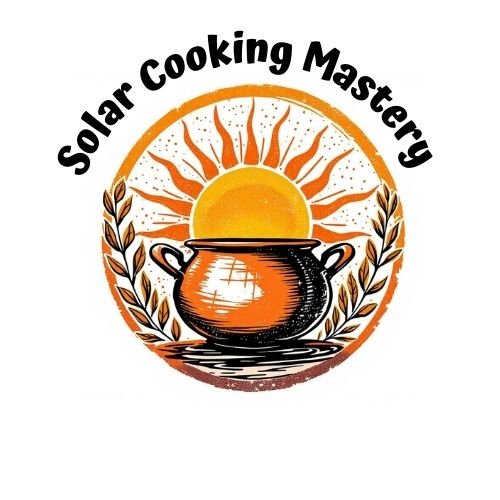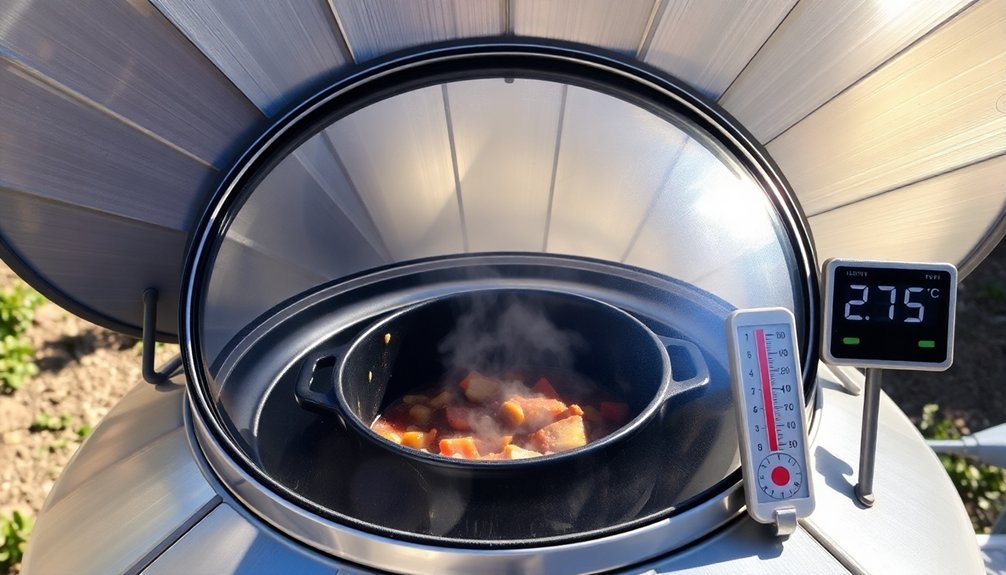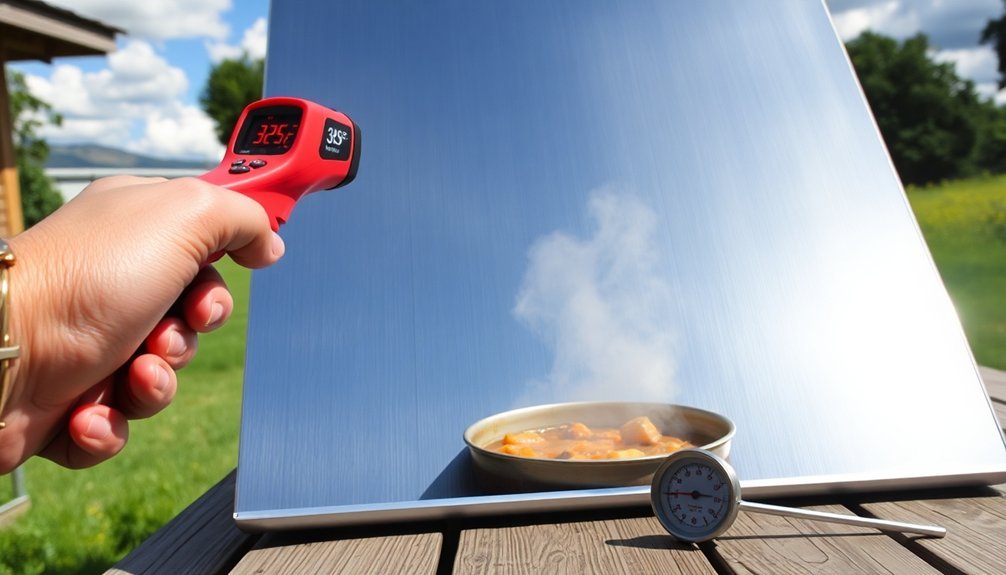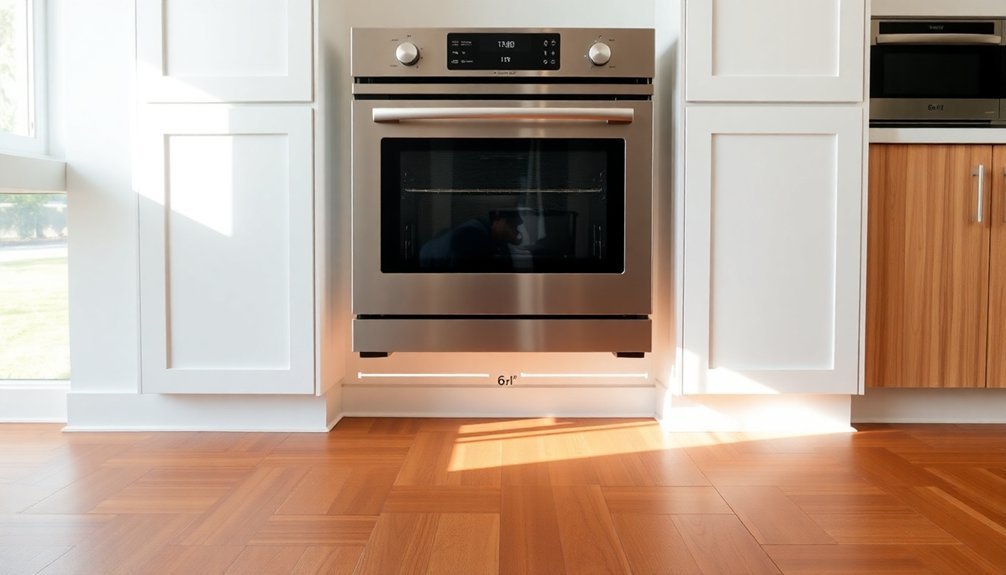To maintain ideal moisture during sun-drying, pre-treat your foods with the right solution based on the type – use salt dips for tomatoes, sodium metabisulfite for color retention, or ascorbic acid to prevent browning. Keep humidity below 60% and temperatures between 120-185°F using a hygrometer for monitoring. Slice ingredients uniformly and position your drying trays in direct sunlight with proper ventilation through slotted vents covered in cheesecloth. Use transparent covers to trap heat while allowing sunlight through, and protect your items at night to prevent moisture absorption. These techniques will preserve up to 95% of your food's nutritional value and enhance its overall quality.
Essential Solar Drying Equipment

A successful solar drying system hinges on having the right equipment and setup in place.
You'll need durable polypropylene copolymer trays that allow proper air circulation, along with transparent or semi-transparent covers made from clear acrylic sheets to trap heat while letting sunlight through.
To protect your food, you'll need to install slotted vents and cover them with cheesecloth or screening to keep insects out while maintaining airflow. Regular tray rotation will ensure uniform drying results throughout your food batches.
Don't forget to include a hygrometer to monitor humidity levels and guarantee your setup maintains temperatures between 120 and 185 degrees Fahrenheit.
Position your dryer in a spot that gets direct sunlight but stays clear of dust, traffic, and pollution.
For unexpected weather, keep a rain shelter or moveable cover nearby to quickly protect your drying food.
Moisture Content Before Drying
Once you've set up your solar drying equipment, understanding proper moisture content becomes the key to success.
You'll need humidity below 60% and warm temperatures for ideal drying conditions. Good air circulation will speed up moisture evaporation from your food. You should use stainless steel trays for optimal sun drying safety.
For the best results, you'll want to dry fruits until they're pliable but not tacky, reaching less than 20% moisture content.
Vegetables should become brittle at 10% moisture. While fruits high in sugar and acid are safe for sun drying, you shouldn't attempt to sun-dry vegetables or meats due to their composition.
Remember to test several pieces for dryness and let them cool for 30-60 minutes before packaging.
If you notice any moisture later, you can re-dry the food at 140°F.
Store your dried foods in airtight containers and check them within a week for moisture.
Pre-Treatment Methods

Before starting your solar drying process, proper pre-treatment of food helps preserve color, texture, and nutritional value.
You'll find that salt dipping and sodium metabisulfite treatments are particularly effective for sun-dried tomatoes. A 10-15% salt solution dip for 5 minutes will enhance storage stability, while a 6-8% sodium metabisulfite dip improves color retention. Turning tomatoes twice each day during drying ensures even results.
For ideal results during pre-treatment, follow these steps:
- Choose between steam blanching (40-60 seconds) or boiling brine immersion if you're processing vegetables.
- Dip your produce in salt solution for 5 minutes to improve rehydration properties.
- Consider alternative methods like ascorbic acid dips or fruit juice treatments to prevent browning.
While blanching alone won't greatly improve quality, combining it with other pre-treatments can help maintain food integrity during drying.
Optimal Weather Conditions
You'll find that clear skies provide the most reliable conditions for sun-drying, as direct sunlight exposure helps maintain ideal drying rates.
Your best results come when temperatures reach at least 85°F with humidity levels below 60%, creating a perfect balance for moisture evaporation.
While these conditions aren't always possible to achieve naturally, you can enhance them by using reflective surfaces and proper air circulation techniques.
Clear Skies Matter Most
When drying food outdoors, clear skies and consistent sunlight are essential for successful preservation.
You'll need to place items in direct sunlight and rotate them regularly to guarantee even drying. Position your drying racks away from shadows and buildings to maximize sun exposure throughout the day.
To achieve peak results, look for these ideal conditions:
- Multiple consecutive days of cloudless skies to maintain consistent drying temperatures
- Hot, dry weather with steady breezes to enhance moisture removal
- Direct sunlight from morning until evening, allowing for continuous exposure
If you're using a reflective surface like aluminum foil, you can boost the drying efficiency by positioning it to redirect additional sunlight onto your food.
Remember to protect your items at night to prevent moisture absorption.
Temperature and Humidity Balance
Maintaining ideal temperature and humidity levels is essential for successful food dehydration. You'll need temperatures between 86°F and 140°F for best results, but don't exceed this range, or you'll risk cooking your food instead of drying it.
Keep humidity below 60% to guarantee moisture moves effectively from your food to the surrounding air.
If you're using a solar dehydrator, you can expect temperatures about 30 degrees higher than the ambient air. Position your dehydrator to maximize heat absorption while protecting food from direct sunlight, which can degrade nutrients.
Add proper ventilation to move moist air away from your food and prevent mold growth. Indoor dehydrators offer more control over these conditions, but if you're drying outdoors, choose dry, breezy days for the best results.
Proper Food Slicing Techniques

Proper slicing techniques form the foundation of successful meal preparation and help maintain moisture in your ingredients. When you're cutting foods for meal prep, it's vital to maintain consistency in size and shape to guarantee even moisture retention during cooking.
- Start with crosscuts to create stable, flat surfaces – this prevents ingredients from rolling and guarantees uniform thickness that's essential for proper moisture distribution.
- Use julienne cuts for vegetables you'll be stir-frying or quick-cooking, as the matchstick shape helps retain internal moisture while allowing for rapid heat penetration.
- Choose precise dicing when you need ingredients to cook at the same rate, as uniform cubes expose equal surface area to heat while keeping the interior moist.
Remember to keep your knife sharp and use smooth, controlled motions for the cleanest cuts possible.
Strategic Tray Arrangement
Set up your meal prep trays in multiple levels to maximize your kitchen space while allowing proper airflow between food items.
When arranging food, you'll want to maintain consistent gaps between pieces to promote even moisture retention through cross-ventilation.
Your spacing should create clear pathways for air movement, typically leaving at least half an inch between food items and ensuring no overlap between layers.
Multilevel Tray Setup
A strategic multilevel tray arrangement can maximize your drying capacity while ensuring consistent results.
Whether you're using an oven, dehydrator, or sun-drying method, proper spacing between trays is essential for maintaining even airflow and preventing moisture buildup.
For best results, follow these key setup principles:
- Position your trays with enough vertical space between them – at least 2-3 inches for proper air circulation.
- Arrange tomato pieces in single layers, never stacking or overlapping them.
- If sun-drying, prop your trays on bricks and cover with cheesecloth.
You'll want to maintain consistent spacing between food pieces on each tray.
For dehydrator use, take advantage of the Parallex system's design, which promotes uniform drying across multiple levels.
Remember to rotate trays periodically if you notice uneven drying patterns.
Cross-Ventilation Spacing Techniques
Building on your multilevel setup, strategic cross-ventilation spacing can dramatically enhance your drying results. Position your trays in open areas where they'll catch prevailing breezes, and maintain 1-2 mph airflow through your drying chamber. You'll want to elevate trays to guarantee air circulation on all sides.
| Spacing Element | Purpose | Ideal Setup |
|---|---|---|
| Height | Air Flow | 6-12" between levels |
| Width | Cross Breeze | 2-3" between trays |
| Angle | Sun Exposure | 15-30° tilt south |
Remember to use screens while maintaining proper ventilation gaps. Place intake vents low and exhaust vents high for natural convection. To boost efficiency by 25%, add reflective surfaces beneath and around your trays. Don't forget to rotate food items regularly for even drying results.
Humidity Control Measures

Maintaining proper humidity levels stands as a critical factor in preserving food freshness during meal preparation.
You'll want to keep relative humidity between 90-95% to prevent moisture loss and maintain peak food quality. Using advanced humidification systems with cold fogging technology helps you achieve precise control without creating unwanted condensation.
To effectively manage humidity during your meal prep, follow these key steps:
- Install humidity sensors in your prep area to monitor real-time moisture levels
- Use non-wetting foggers that create fine droplets for even distribution
- Guarantee proper ventilation to remove excess ethylene gas while maintaining moisture
Night Protection Protocols
You'll need to secure your food covers promptly after sunset to shield meal prep items from nighttime exposure.
It's crucial to use moisture-resistant covers that prevent condensation from forming on your prepped ingredients during overnight storage.
Take extra precautions to shield your food from evening humidity by placing containers in a climate-controlled environment with proper ventilation.
Secure Covers After Sunset
As night falls, protecting your prepared food from insects, moisture, and other environmental factors becomes essential for maintaining its quality.
You'll need to secure your food with proper covers and move it to a sheltered location to prevent dew accumulation.
- Place a cheesecloth or mesh covering above your food, ensuring it's suspended and doesn't make direct contact with the items.
- Position trays in a dry, well-ventilated area with good air circulation, elevating them on blocks for better airflow.
- Set table legs in water-filled cans to create a barrier against crawling insects.
If you're using hanging methods, string your food items on strong thread and position them in a protected space.
Remember to maintain proper spacing between items to allow continued air circulation throughout the night.
Moisture Prevention At Night
Proper nighttime moisture control requires specific protocols beyond basic covering techniques.
You'll need to relocate your drying trays to a sheltered area that's dry and well-ventilated to combat evening dew and moisture. Don't place trays directly on the ground; instead, use elevated racks or screens on a concrete surface.
Position your food on racks that allow air to flow from all directions, keeping items in a single layer with space between pieces.
For extra protection, suspend food items on strong thread in your sheltered space. You can place table legs in water-filled cans to deter crawling insects while maintaining good airflow.
Monitor your items regularly for signs of spoilage and be ready to switch to oven drying if wet weather persists.
Storage Container Selection

When selecting storage containers for meal prep, durability and safety features should be your top priorities.
You'll want containers that keep your food fresh while preventing leaks and moisture loss. Borosilicate glass and food-grade plastic options offer excellent versatility, as they're typically safe for microwave, freezer, and dishwasher use.
Look for these essential features:
- Airtight lids with silicone seals to lock in moisture and prevent leaks
- Clear, stackable designs that help you organize and identify contents easily
- Heat-resistant materials that won't warp or release harmful chemicals
Don't forget to check the temperature limitations of your chosen containers.
While glass can handle extreme temperatures, plastic options like Tritan and PP have restrictions around 185°F. Always avoid using sharp utensils that could damage your containers' surfaces.
Rehydration Best Practices
Rehydrating dehydrated foods requires attention to detail and the right timing for ideal results. You'll find that less dense foods like corn rehydrate faster than denser items like mushrooms, so adjust your timing accordingly.
Choose from several effective methods: Pour boiling water over your dried food and wait 20-45 minutes, or use an overnight soak for complete rehydration.
For quicker results, try the insulated pot technique by mixing equal parts water and food, soaking for five minutes, then bringing to a boil for two minutes. Let it sit for ten more minutes.
If you're using silicone bags, add boiling water directly to your meal and place it in an insulated pouch for 10-15 minutes.
Don't discard the rehydration water – it's perfect for incorporating into your meal preparation.
Frequently Asked Questions
Can Different Types of Foods Be Dried Together on the Same Tray?
You shouldn't dry different foods together on the same tray. While fruits can be combined with other fruits, they'll have varying drying times, and mixing food types can lead to flavor conflicts and safety issues.
How Long Can Sun-Dried Foods Remain Safe When Stored in Oil?
You'll get up to 1 year of shelf life for fully dried foods stored in oil when kept in a cool, dark place. For safety, it's best to use them within 6 months and refrigerate after opening.
What Alternative Methods Exist if Sunshine Becomes Limited Mid-Drying Process?
If you're caught with limited sunshine mid-drying, you can switch to an electric dehydrator, oven drying, air drying, or solar dehydrator. These methods will complete your drying process regardless of weather conditions.
Does Altitude Affect the Time Required for Sun-Drying Foods?
Yes, altitude impacts your sun-drying time. You'll find food dries faster at higher elevations due to lower air pressure and humidity. However, you'll need to monitor temperature changes carefully for ideal results.
Can Seasonings Be Added During the Drying Process for Flavored Results?
Yes, you can add dried herbs and spices during the drying process. Just sprinkle them lightly over your food before drying begins. Use only dried seasonings to avoid adding moisture that could affect drying time.
In Summary
You'll find solar food drying is a rewarding way to preserve food while retaining nutrients and flavor. By following proper pre-treatment methods, maintaining ideal moisture levels, and using appropriate storage containers, you've guaranteed your sun-dried foods stay moist enough to rehydrate well. Remember to protect your drying foods at night and monitor weather conditions closely. With these techniques mastered, you're ready to create delicious sun-dried meals.





Leave a Reply